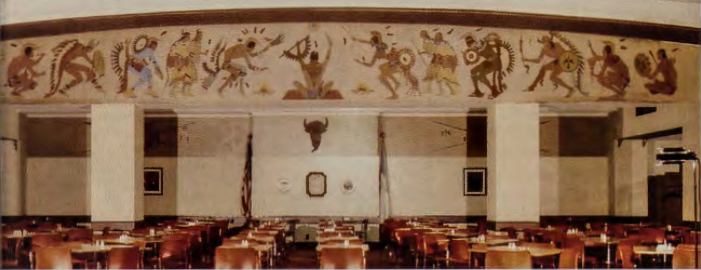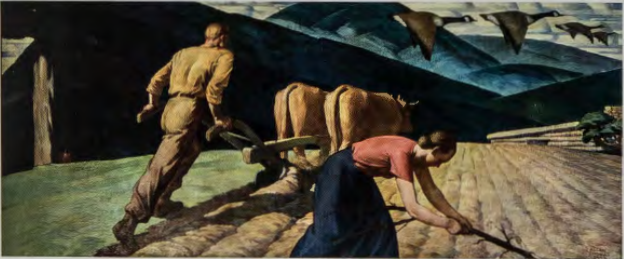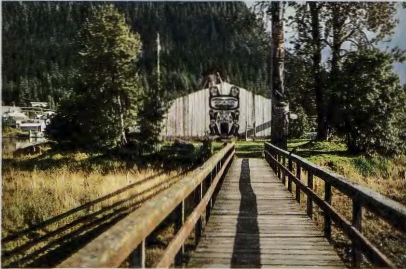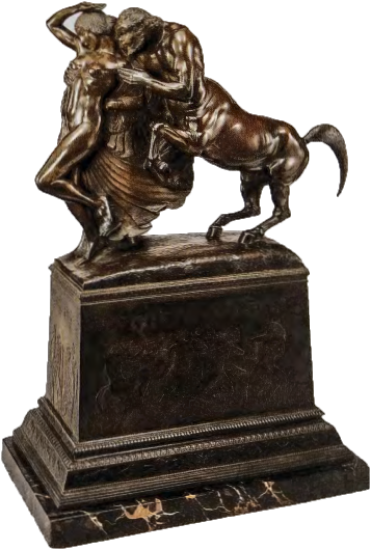16.2: Federal Patronage- Roosevelt's Works Progress Administration (WPA)
( \newcommand{\kernel}{\mathrm{null}\,}\)
"How can a finished citizen be made in an artless town?" Postmaster Basil V. Jones11
The turn to a more public, democratic art was energized by the most massive public works initiative in American history. Franklin D. Roosevelt's New Deal (1934- 41) was put into place at the height of the Depression, when one out of four working Americans was unemployed. The New Deal's Works Progress Administration was a cluster of federal agencies, each with its own acronym, administering a range of publicly funded programs intended to put Americans back to work. The New Deal was directed at not only economic but moral recovery- an effort to rally public support for the government by invoking familiar images and shared values. Much public art of the New Deal was directed at conserving a cultural heritage that was itself being defined throughout the 1930s. Its appeal was broadly populist. Artists male and female , black, white, and Native, were recruited to work on New Deal programs, not only in the visual arts but in theater and other programs as well. Far from undermining capitalism, as some of its opponents claimed, Roosevelt's New Deal reinforced its foundations by restoring economic health and (ultural viability.
Art Programs of the New Deal
The art programs of the New Deal consisted of the Public Works of Art Project (1933-4); the Treasury Section of Fine Arts (1934-43); the Treasury Relief Art Project (1935- 8); and the Federal Art Project (1935-43). The Treasury Section awarded commissions competitively; 1116 murals were completed in 1083 cities throughout the country. The Federal Art Project, by contrast, was need-based, putting thousands of artists to work at the height of the Depression years. Its objective was to broaden the role of the arts in public life, bringing the artist "into closer touch with American life," and furnishing alternative support for artists who had become dependent on an elitist and narrow art market. The years between the wars saw a similar expansion in Germany, Russia, and Mexico of government involvement in the arts as vehicles of propaganda and public education. In the United States, controversy about government patronage arose from the tension between the democratic philosophy of public representation and the exercise of control over decisions by hand-picked professional boards. As the scholar Andrew Hemingway has pointed out, the public art of the WPA suffered from a fundamental conflict at the heart of its consensus model of U.S. culture: a model that assumed that everyone shared basic beliefs and agreed on the direction of American society. Yet the government's pursuit of such a consensus and its expression in unifying national myths was troubled by the gap between myth and the realities of ethnic, class, and gender inequality. New Deal public art represented both possibilities, underwriting a pluralistic vision of national inclusiveness, as well as engineering consensus in the face of a divisive and contentious history.12

A FRESCO FOR A GARMENT WORKERS' COMMUNITY. Ben Shahn's fresco for the Jersey (now Roosevelt) Homesteads in New Jersey (fig. 16.15) was done with the assistance of Shahn's partner, the artist Bernarda Bryson (1903- 2004). The Jersey Homesteads, created under the New Deal's Resettlement Administration (1935- 7), was a cooperative community for New York Jewish garment workers. Combining farming with factory work, the Homesteads gave workers a new start in life through land ownership and farming, while providing them with additional sources of income. They could, as one supporter put it, "sew and sow at the same time."13 The mural begins on the upper left with the persecution of Jews in the pogroms of Eastern Europe, and then in Hitler's Germany, signaled by a Nazi soldier (unique in New Deal murals, according to the scholar Diana Linden). At the center left, a group of immigrants, including Shahn's friend the artist Raphael Soyer, Shahn's mother, and Albert Einstein, cross a bridge. Here, the Old Testament story of the Exodus across the Red Sea merges with New World myths of migration. To the lower left is Ellis Island, with its gridded spaces, American flag, and Statue of Liberty. The central sections of the mural show New York's low-wage garment factories; the background scene alludes to the devastating Triangle Shirt Waist Factory fire, which took the lives of 146 women in 1911. The union movement- so critical to securing the rights of immigrant workers-is represented in portraits of labor leaders including CIO (Congress of Industrial Organizations) founder John L. Lewis. Creating a continuous narrative linking Jewish and American history, Shahn's mural served the multiple identities of those living in the Homesteads, as exiles from the Old World and as pioneering Americans, struggling to rebuild.
Montaging scenes and locations, combining a horizontal narrative arrangement with spatial depth, Shahn's mural revealed its debt to Diego Rivera, whom Shahn had assisted at Rockefeller Center. Montage allowed Shahn to compress into one wall a series of places and events spanning two continents and decades of time. Such montaging leaves the precise narrative construction up to the viewer. This unsettling of an established narrative sequence has the effect of activating public art as a space of historical memory tied to the present. In its cinematic sweep from past to present and future, its history of sacrifice and redemption, Shahn's mural also paid tribute to the idealism of the New Deal, integrated within a broader narrative of Jewish pilgrimage toward a better life.
A NATIVE AMERICAN MURALIST AT THE DEPARTMENT OF THE INTERIOR. Among the best-known New Deal art projects were the large-scale public murals painted in post offices and other public buildings across the country. Embodying the democratic ideals of the New Deal, the range of artists chosen to participate included Native and African Americans. Native artists such as the Kiowa painter Stephen Mopope (1898-1974) painted murals at the University of Oklahoma in Norman, and at the State Historical Society Building in Oklahoma City, in the 1930s. In 1939, he and five other Native artists from the Plains and Southwest were among those chosen to decorate the walls of the gigantic new Department of the Interior Building, which opened in Washington, D.C. in 1937. Secretary of the Interior Harold Ickes, long an advocate of Indian causes, was adamant that the building would include work by Indian artists, overseeing the choice of artists himself.
While most workers in New Deal projects were paid a modest hourly or monthly wage (the Civilian Conservation Corps workers, for example, earned $30 per month), the professional artists who worked for the Section of Fine Arts were chosen by recommendation or competition, and their pay was based on the square footage allotted to them. The Department of the Interior muralists were paid the same amount regardless of race or gender ( an unusual practice in the 1930s, when white workers routinely earned more than black or Native workers, and men were paid more than women).

Mopope's mural on the 50-foot-long arching lunette on the east wall of the basement cafeteria is a frieze of single processional life-sized figures (fig. 16.16). They rise from seated positions on either end to varied standing dance poses. They move in profile from each end toward the central seated figure, seen from the rear. In addition to being an accomplished painter in both large- and small-scale work, Mopope was himself a dancer in pow-wows and other competitions. The repeating silhouetted forms of his mural suggest the rhythms of the dance.
Like other artists of this era, the Indian painters who worked on these commissions remembered this work fondly in their later years. Despite the exacting specifications and bureaucratic nature of the commission and design process, they were grateful for work in their chosen professions at a time when many Americans had no work. Though such murals present a romantic view of American Indians frozen in the traditional past, they were painted by cosmopolitan Native artists whose work by this time had been exhibited all over the United States and in Europe.

A TYPICAL POST OFFICE MURAL. A common theme of the Treasury Section's post office murals was the founding of communities. Allan Thomas's (1902-74) mural for Crystal Falls, Michigan (fig. 16.17) connects the local history of the town to frontier settlement: in stylized forms, an upright male farmer prepares to seed the soil, working alongside a woman whose horizontal bend associates her with the earth. The figures dominate the view, animating the landscape in a tableau that was echoed in the federal theater programs of the same years as well as in the earth-bound choreography of the dancer Martha Graham (1894-1991). Here the present is linked to a reassuringly familiar set of ostensibly shared communal myths relating to pioneer origins, a world of complementary and non-competing gender divisions, and traditional forms of agriculture. Seeking consensus in a mythologized past, much public art of the New Deal avoided provocative subjects engaging the problems of uneven power that motivated the social activism of the 1930s.
A New Deal for Indians
Part of Roosevelt's New Deal was directed at the documentation and preservation of the nation's cultural heritage, including the arts of Native peoples-another example of the "Searching for Roots" examined in the previous chapter. The Indian Arts and Crafts Board, created in 1935, fostered economic development on reservations through the promotion and sale of Indian crafts. It developed standards of excellence for Indian silverwork and Navajo weaving, and sought to ensure that Natives themselves made the products sold at trading posts and in tourist shops. The Indian Arts and Crafts Board also played an important role in redirecting attention from ethnographic to aesthetic interest in ancient, historic, and contemporary Native arts, through exhibitions at the Museum of Modern Art in 1941 and elsewhere. In New Mexico, Bandelier National Monument (an ancient Pueblo archaeological site) was excavated and restored under the auspices of the Civilian Conservation Corps. Other CCC projects included the restoration of major totem poles in Alaska. Some poles were removed from isolated and abandoned sites and relocated in Native towns such as Sitka. Other poles, too decayed for restoration, were carved anew. In this project, Native carvers and elders were called upon for their expertise, and some young Native men, paid by the federal government, learned to carve in the old ways.

THE RENOVATION OF CHIEF SHAKES' HOUSE. One of the most notable projects of the CCC in Alaska was the renewal of Chief Shakes' Community House in Wrangell (fig. 16.18). As a model for the exterior painting on this house, the artists used a famous nineteenth-century Grizzly Bear screen (see fig. 7-28) for the bear emblem belonging exclusively to Chief Shakes. In Northwest Coast cultures, only the owner of a design has the right to display and use it. By the late nineteenth century, Chief Shakes' House was clapboarded and outfitted with glass windows and a door. The restored house, built by a CCC team that included local Tlingit men, was an idealized replica of a century-old house form. The crew painstakingly reproduced traditional mortise and tenon joinery characteristic of ancestral Tlingit architecture. Using commercial paints, they matched the old colors made with natural pigments. The dedication of the restored house in 1940 was the occasion for Charley Jones, who had worked on the crew, to assume his hereditary title as the seventh Chief Shakes.14 Thus both Tlingit and federal aims were served in this project. Chief Shakes' House was meant both to serve as a magnet for tourists and to encourage Native pride. It continues to do both.
Archaism in Public Sculpture
The term "archaism" denotes a return to the beginning (arche in Greek), signaled by the use of styles associated with ancient forms. Unlike modernist primitivism, which looked to tribal arts, archaism looked to the courtly sculptural traditions of both the East (taking in India, Assyria, and Egypt) and the West (Greece). It was a tendency well suited to the monumental forms preferred for public sculptural commissions.

Paul Manship (1885-1966), perhaps the best-known American sculptor in the years between the wars, helped to popularize archaism in the United States. Like modernism, archaism renounced naturalism in favor of stylized form, drawing upon archaic Greek, Assyrian, and classical Indian sources, all of which shared an emphasis on silhouette. This stylization of form appealed to a "middlebrow" modernism that signaled sophistication without the challenges of "high" modernism. Archaism extended the cosmopolitan conversations American art had carried on with other global traditions since the later nineteenth century. Manship's Centaur and Dryad established the language of archaism by the early 1910s (fig. 16.19 ), revealing his taut design sense, his articulation of draperies through rhythmically incised lines, and his attention to the relationship of voids to solids. These qualities won him popularity with critics and public alike for their accessibility and their grounding in ancient myth.

By the 1930s, monumental public sculpture throughout Europe and the United States had adopted the conventions of archaism-stylization, incisive silhouette, planar forms, and solid compact shapes-that came to prevail in the state-sponsored and institutional sculpture not only of Roosevelt's America, but of Nazi Germany and the Soviet Union under Stalin. With its stylized forms, archaism was well suited to placement within the classicizing architecture of power-both private and public-that left its mark on institutional and government centers between the wars. Archaism was also the style of choice for the sculptures of the Federal Triangle along the mall in Washington, D. C., and at state capitols and public monuments built during the 1930s throughout the nation. Located next to the Federal Trade Commission building, Michael Lantz's (1908-88) 1942 sculpture Man Controlling Trade (fig. 16.20) employed a familiar language of heroic masculinity that spoke to the national crisis of confidence. Drawing on an iconography going back to ancient Rome (the Dioscuri, or Horse Tamers), Lantz allegorized the market as an unruly animal requiring domestication. Reassuringly grounded in older forms and symbols, archaism proved an effective language for public sculpture. However, it was later condemned by modernist critics as "middlebrow" kitsch because of its emphasis on the decorative quality of line and its reluctance to challenge the public. Though it was banished from the Museum of Modern Art, it still sits comfortably in our public landscape, simultaneously part of a familiar national idiom and an international mainstream.


